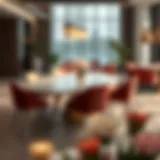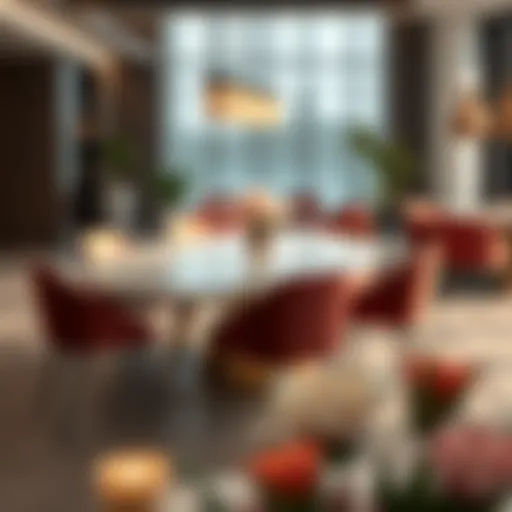Exploring the Benefits of UV Resistant Fake Plants
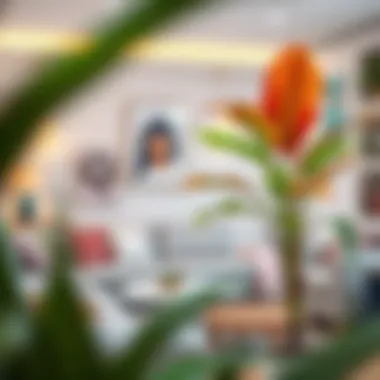

Intro
As more people rush toward green solutions in home and commercial spaces, UV resistant fake plants have carved a niche that’s hard to ignore. These lifelike alternatives not only beautify interiors and exteriors but also withstand the wear and tear inflicted by sun exposure. The versatility, practicality, and low maintenance needs make them a go-to choice for many homeowners and designers alike.
In a world where sustainability meets aesthetics, the significance of these faux plants cannot be overstated. They offer an environmentally friendly option, especially when considering spaces with limited natural light or areas where nurturing real plants may not be feasible. This artice journeys through the core aspects of UV resistant fake plants—showing their durability, discussing aesthetic benefits, and shedding light on material quality—all while keeping our discerning readers informed on the best practices for integrating these green accents into various design philosophies.
Furniture Design Trends
Current Styles and Aesthetics
The trend today is all about balancing comfort with style, where UV resistant fake plants play a pivotal role. Homeowners and designers increasingly favor a natural look, which these faux plants can effortlessly deliver. From sleek modern to rustic charm, faux greenery fits any aesthetic.
Incorporating these plants into furniture design has brought about innovative blends of textures and shapes. Picture a minimalist living room featuring a sculptural faux fiddle leaf fig in a matte black pot, or a bohemian space embellished with cascading ivy. This adaptability makes them an essential asset in today's design toolkit.
Color Palettes and Material Choices
When thinking about color palettes, homeowners often lean toward earthy tones, bringing an organic feel indoors. The subtle greens, deep browns, and soft neutrals blend seamlessly with wood and metal, creating a layered look. Material choices for UV resistant fake plants have evolved too—visibly durable, yet incredibly lifelike materials such as polyethylene and polycarbonate dominate the market. These materials not only protect against UV rays but also resist fading, keeping spaces vibrant and inviting.
Here are some popular combinations:
- Modern: Shades of grey and white, with pops of green from faux succulents.
- Rustic: Earthy browns paired with rich greens from ivy and ferns.
- Bohemian: Textured textiles and colorful pots accentuating intricate faux plants.
This combination of aesthetically pleasing designs and durable materials resonates with those wanting durability alongside beauty.
Practical Applications in Home and Commercial Spaces
While the aesthetic appeal is evident, the practical applications of UV resistant fake plants are equally important. Their ability to endure harsh sunlight without losing their charm makes them ideal for a variety of settings—from chic cafes serving al fresco dining to swanky offices with sunlit break rooms.
"Integrating UV resistant fake plants allows for rich greenery without the commitment of caring for real plants. A breath of fresh air without the upkeep!"
Environmental Considerations
It's easy to overlook the ecological impact of using fake plants. However, sourcing materials responsibly can create a powerful narrative. Many manufacturers now focus on eco-friendly materials and biodegradable options, enhancing the appeal for environmentally conscious buyers.
Maintenace Needs of UV Resistant Fake Plants
While these plants are relatively hassle-free, they benefit from occasional cleaning to keep them looking their best. Dust can collect on their surfaces, dulling their appearance. Using a soft, damp cloth can do wonders to refresh them—just avoid any harsh chemicals.
Understanding UV Resistant Fake Plants
In recent years, as the enthusiasm for indoor and outdoor decor has surged, so too has the interest in UV resistant fake plants. This growing trend is not just about decorating spaces; it's also about enhancing living environments that are practical, sustainable, and aesthetically pleasing. Understanding these artificial plants is crucial for homeowners, designers, and anyone considering them as part of their decor. The significance lies not only in their beauty but also in how they serve as a versatile solution to many challenges faced in design.
Definition and Characteristics
UV resistant fake plants are essentially synthetic replicas designed to mimic real plants while possessing the ability to endure sunlight without fading or degrading. These are not your average plastic greenery; they are crafted with a level of detail that can often fool even the most discerning eye. The standout feature here is their resistance to ultraviolet rays, which means they can retain their color and appearance much longer than standard imitation plants.
Characteristics of UV resistant fake plants include:
- High-Quality Materials: Many of these plants use polyethylene or polyblends that are treated to withstand sun exposure, making them suitable for both indoor and outdoor settings.
- Realistic Appearance: From the texture of the leaves to the vibrancy of the colors, the most premium versions come alarmingly close to their living counterparts.
- Low Maintenance: Unlike living plants that require watering, sunlight, and pruning, UV resistant fake plants need very little. A dusting now and then is usually enough, appealing to those looking for a more hassle-free alternative.
This combination of traits not only enhances interior spaces efficiently but also offers durability in conditions that would typically challenge natural flora. For individuals or businesses looking to add greenery without the headaches of upkeep, these plants serve as an ideal solution.
The Technology Behind UV Resistance
The technology that grants UV resistance is a noteworthy aspect of these artificial plants. It involves innovative manufacturing processes that integrate UV stabilizers into the plastic materials. These stabilizers absorb the UV radiation that can cause fading, effectively shielding the colors within the material from damage.
Additionally, the production process may utilize special pigments designed to withstand prolonged sunlight exposure. As a result, the colorfastness of these plants is impressive, allowing them to sit brightly in the sun without losing charm or vibrancy. This technology not only prolongs the life of the plants but also ensures that they remain visually appealing for years to come.


"Investing in UV resistant fake plants is like planting an everlasting garden that doesn’t ask for a drop of water!"
The Benefits of UV Resistant Fake Plants
The world we live in today has a never-ending demand for convenience and aesthetic appeal, and that's where UV resistant fake plants come into play. These plants not only bring a splash of green into a home or business, but they also support a myriad of practical benefits. Their longevity, cost-effectiveness, and adaptability to different environments make them an appealing choice for many. Let’s break these benefits down further into three distinct categories:
Longevity and Durability
When it comes to longevity, UV resistant fake plants are akin to fine wine; they only get better with time. Unlike their real counterparts, which suffer from natural wear and tear due to sunlight, water, and pests, these artificial plants are designed to withstand the elements. The UV protection integrated into their production ensures that colors remain vibrant for years, even when exposed to direct sunlight.
"With UV resistant fake plants, you’re essentially investing in a lifestyle choice that prioritizes endurance over temporary beauty."
Consider a rooftop garden or a patio area. Real plants may require constant care and watering, but fake plants can maintain their allure and freshness without the extra fuss. This durability allows homeowners and designers to place these plants wherever they please—no shady corners or careful positioning needed.
Cost-Effectiveness
On the financial side, UV resistant fake plants offer a sensible solution for those looking to beautify spaces without breaking the bank. Initially, the investment might seem higher than purchasing a few potted plants, but when you consider the long-term savings, the numbers add up. Real plants need constant attention, including regular watering, fertilizing, pest control, and even replacement as they wither away.
- Think about:
- Higher utility costs due to extensive watering systems.
- The price of fertilizers and other plant care necessities.
- Labor costs, if hiring maintenance professionals.
When you contrast that with the one-time purchase of a high-quality fake plant, it’s clear that these greens are a cost-effective alternative for business owners and homeowners alike. They require minimal to no maintenance, which frees up both time and budget for other important things.
Aesthetic Versatility
Aesthetic appeal is perhaps the strongest argument for incorporating UV resistant fake plants into any space. These plants come in a multitude of styles, sizes, and colors, ensuring that there is something to fit every unique taste and environment.
From tall, leafy faux trees in a lobby to small potted succulents gracing a coffee table, the options are nearly limitless. You can match them to any decor theme, be it rustic, modern, or somewhere in between.
- Consider these popular designs:
- Fiddle Leaf Fig: A trendy choice known for its impressive leaves.
- Succulents: Perfect for minimalists, adding charm without clutter.
- Potted Lavender: For those who love a bit of color and a touch of calm.
Using these plants not only enhances visual interest but also creates a welcoming atmosphere, making spaces more inviting for guests or clients. They truly provide that refreshing, verdant touch without the baggage that comes with real plants.
In summary, UV resistant fake plants offer plenty of tangible benefits for homeowners, designers, and business environments. Their longevity, cost savings, and aesthetic flexibility are testament to their enduring appeal. By opting for these artificial beauties, you enhance your surroundings while easing your lifestyle.
Application Areas for UV Resistant Fake Plants
Understanding the application areas of UV resistant fake plants unfolds a myriad of possibilities for homeowners and businesses alike. They stand as versatile alternatives to natural flora, offering flexibility without compromising aesthetics. From cozy living rooms to bustling commercial spaces, these plants add a touch of life and vibrancy where traditional plants may struggle to thrive. Below, we explore their significance in residential, commercial, and outdoor environments, highlighting varying benefits and considerations that come into play in each context.
Residential Spaces
In the realm of residential spaces, UV resistant fake plants have made a substantial mark. Many homeowners yearn to have a green touch in their abodes, yet the realities of maintenance often leave them high and dry. Genuine plants require watering, sunlight, and sometimes even special care. Here’s why UV resistant fake plants become the go-to option:
- Low Maintenance: Conceivably the most enticing feature is the minimal effort required. No wilting, no watering, just a simple dusting every now and then. They're perfect for those who have busy lives, or perhaps travel often.
- Enduring Beauty: These faux plants maintain their vibrant colors and lifelike appearances year-round, irrespective of the climate. This consistency can bring warmth and liveliness to any room.
- Design Flexibility: If you’re into interior design, fake plants can be placed in various locations without worrying about sunlight. They can adorn coffee tables, shelves, or even bathrooms, adding an unexpected twist to the decor.
Commercial Environments
Businesses are increasingly opting for UV resistant fake plants in their workspaces. The desire to create an inviting atmosphere is strong, and every little detail matters in making clients feel at home. Here’s how these faux plants shine in commercial settings:
- Professional Appeal: They enhance the aesthetic of offices, hotels, and restaurants, setting a welcoming tone. In a café, for instance, a well-placed fake plant can make the space warm and inviting without the hassle of maintaining real plants.
- Cost Efficiency: For businesses, maintaining a lush look can mean high costs, particularly if hiring an outside service for upkeep. Fake plants cut down on these expenses, freeing up resources for other critical areas.
- Durability in High Traffic Areas: Unlike their real counterparts that can easily be damaged or die in busy settings, these faux versions withstand the test of time and foot traffic, making them ideal for corporate environments.
Outdoor Settings
When it comes to outdoor settings, UV resistant fake plants offer a unique value proposition. The good ol' outdoors can pose various challenges, from intense sunshine to unpredictable weather. Here’s how fake plants find their way into exterior spaces:
- Weatherproof Quality: UV resistant fake plants are designed to withstand harsh sunlight, rain, and wind. They can be safely displayed on balconies or patios without fading over time.
- Ideal for Hard-to-Reach Areas: Got a corner of your garden that's tough to maintain? Homeowners often face the dilemma of having a lush yard while managing areas with less favorable conditions. Fake plants fit perfectly as a solution, filling in the gaps seamlessly.
- Creating Ambiance: Whether it’s around a pool area or the entrance of a garden, faux greenery creates an inviting atmosphere that natural plants can struggle to maintain. They establish an aesthetic vibe, intended to impress guests and homeowners alike.
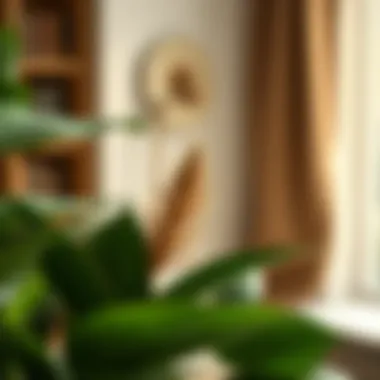

In essence, the application of UV resistant fake plants proves to be an innovative and practical choice across various settings. As trends evolve and design sensibilities shift, these plants not only meet aesthetic preferences but also cater to the practical needs of today’s busy lifestyles. The enduring appeal lies in their versatility, allowing for creative and effective uses in any environment.
Choosing the Right UV Resistant Fake Plant
When selecting UV resistant fake plants, proper consideration is vital for both aesthetic coherence and practical functionality. Choosing the right plant can transform a mundane space into a lush sanctuary or refined commercial environment. While the allure of greenery is universal, integrating faux flora requires attention to material quality, style, and even the specific ambiance you wish to foster.
Material Quality Considerations
The foundation of a satisfying experience with UV resistant fake plants lies in the material they are made of. A common misconception is that all fake plants are created equal, but this couldn't be further from the truth. Recognizing the different qualities in materials will aid in selecting options that not only look authentic but also withstand time and elements.
- UV Resistance: Look for products labeled specifically for UV resistance. Premium polyethylenes or polyvinyl chlorides are generally good bets, ensuring colors don’t fade under the sun’s relentless gaze.
- Texture and Detail: Observe the feel and detail of the plant. A realistic appearance isn’t just in its shape but also in the texture. Choose plants with varied leaf shapes and subtle color changes that mimic natural ones.
- Weight and Stability: Consider the weight of the fake plants. Heavier models are less prone to tipping over in a breeze. On the other hand, lightweight options might be better for easier relocation but could require anchoring if used outdoors.
- Maintenance: Some materials require specific cleaning protocols; hence, making let’s say a high-density polyethylene option the better choice for busy households.
By being mindful of these elements, one can avoid pitfalls related to subpar quality that may only be realized after the purchase has been made.
Style and Design Options
Style and design also play a pivotal role in the journey to finding the ideal UV resistant fake plant. The choices range from classic to modern, allowing for flexibility that suits various decor themes. Here are essential aspects to consider:
- Color Palette: The color of the plants can greatly affect the overall atmosphere. Choose shades that complement your existing decor. Bright greens can uplift a space, while deep, muted tones can offer a soothing effect.
- Size Variety: Think about scale. A large faux fiddle leaf fig can be a significant statement piece in a spacious living room, while petite succulents are perfect for enhancing a shelf or table. Consider your space's dimensions when selecting.
- Plant Types: The universe of fake plants offers a wide variety including trees, bushes, and smaller plants that can be used as centerpieces. Mixing different types can create a dynamic display that feels more organic.
- Placement: Think carefully about where you'll display these plants. Certain designs work better in particular settings. For instance, a trailing ivy looks striking cascading over the edge of a shelf, whereas a tall snake plant fits well in a corner providing a vertical presence.
Ultimately, the right choice of UV resistant fake plants, considering both material and design, is essential in elevating any setting while ensuring longevity.
"A perfect faux plant is not just about looking good; it’s about fitting in the narrative of your space."
By considering material quality and design options, homeowners, designers, and anyone interested in enhancing their space will find themselves much better equipped to make informed selections.
Care and Maintenance of UV Resistant Fake Plants
When integrating UV resistant fake plants into your home or commercial space, understanding how to care for these green alternatives is crucial. Although they are designed to withstand sun exposure and require less upkeep than live plants, regular maintenance goes a long way in ensuring these decorations look their best. Proper care not only prolongs their lifespan but also maintains their aesthetic appeal.
Cleaning Practices
Keeping UV resistant fake plants clean is essential to avoid that dusty, drab look that can dull their vibrant colors. Here's how to maintain their fresh appearance:
- Dust Regularly: A feather or microfiber duster does wonders for day-to-day maintenance. It snags dust without scratching the surface. Just a quick swipe should do the trick.
- Use Warm Soapy Water: For deeper cleans, mix warm water with a gentle soap. Dip a soft cloth into the solution, wring it out, and gently wipe down the leaves. Be careful not to soak them, as excess water may affect the structural integrity.
- Rinse When Necessary: Sometimes, a plant's beauty can be hidden under layers of grime. After cleaning with soapy water, rinsing with plain water can bring back that vibrant sheen. Make sure the fake plant dries thoroughly to avoid any mold growth.
Storage and Protection
Correct storage and protection of UV resistant fake plants is just as vital as keeping them clean. During off-seasons or if you're renovating, these simple steps can ensure that your plants stay in top shape:
- Store Indoors: If possible, storing your fake plants indoors can shield them from harsh weather conditions that might affect their appearance.
- Use Storage Containers: Find breathable containers or bins that protect the plants from dust and other particles while allowing them to air out.
- Avoid Compression: Make sure the plants are not squished together in storage; this could result in shape deformation. Instead, give them enough room to breathe.
- Cover with Fabric: For prolonged storage, consider covering your plants with a soft fabric to ward off dust. Just ensure that the fabric is clean.
By following these care and maintenance tips, you'll not only keep your UV resistant fake plants looking their best but also enhance their longevity and durability, making them an investment that continues to pay off in aesthetics and utility.
Environmental Impact of Fake Plants
Understanding the environmental impact of fake plants, particularly UV resistant varieties, is crucial as these items gain popularity for home and commercial spaces. While they provide aesthetic solutions, it's essential to ponder their ecological footprint compared to traditional plants. The focus here is not only on the materials used but also how they stack up against real greenery, which plays a significant role in our ecosystems.
Sustainability of Materials Used
When discussing UV resistant fake plants, a significant factor stems from the sustainability of the materials from which they're crafted. Manufacturers typically utilize materials like polyethylene, polyester, or plastic, which often come with concerns regarding their biodegradability.
However, in recent years, investment in recyclable and eco-friendly materials has ramped up, allowing for options that are both durable and less harmful to the environment. Here are a few noteworthy points regarding sustainability:
- Recyclability: Some brands now emphasize the use of recyclable substances in their production process. Customers can not only enjoy their plants but also rest easy knowing they are contributing less to landfill waste.
- Life Cycle Assessment: It's critical to consider the life cycle of fake plants—from production to disposal. Opting for products with a longer lifespan can lead to positive ecological outcomes.
- Manufacturing Processes: More manufacturers are adopting energy-efficient processes, which can reduce carbon emissions associated with production.
- Innovative Materials: Companies are exploring alternatives to conventional plastics; advanced bioplastics, derived from renewable sources, emerge on the scene. Such adaptations signify a shift toward greater sustainability within this niche.
Ultimately, homeowners and designers should pay close attention to the specifications of the fake plants they choose. Finding a balance between style and environmental impact can be an enriching endeavor.
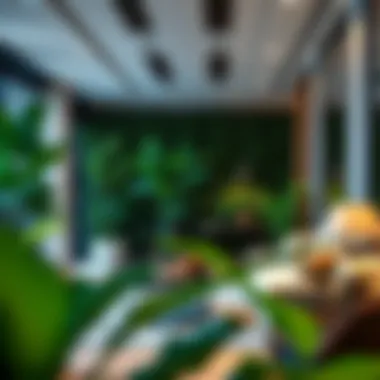

Comparison to Real Plants
Traditionally, real plants have been celebrated for their myriad benefits, including purifying air, enhancing mood, and contributing to biodiversity. Yet, fake plants come with a notable set of advantages when considering their impact on both the environment and practicality.
- Maintenance: Real plants often demand considerable care like regular watering, pruning, and even treatment against pests. In contrast, UV resistant fake plants only require occasional dusting or rinsing, effectively reducing resource consumption over their lifespan.
- Water Conservation: Perhaps one of the most compelling arguments is the water they conserve. In many areas, water shortages are increasingly common. Fake plants, lacking a need for hydration, provide a sustainable way to enjoy greenery without straining this precious resource.
- Environmental Stability: Certain species of real plants may struggle to thrive in specific climates or indoor conditions. Fake plants, on the other hand, maintain their appearance and integrity regardless of environmental stressors, like extreme heat or low light. This aspect may prove to be quite advantageous in commercial settings where maintaining live plants could be expensive and labor-intensive.
- Impact on Biodiversity: By utilizing fake plants instead of real ones, particularly in high-traffic commercial areas, there is a reduced risk of harming local ecosystems that live plants could disrupt. While it's crucial to consider our planet's biological diversity, responsible sourcing of fake plants can alleviate potential environmental concerns.
Trends in the Fake Plant Market
In recent years, the fake plant market has seen a considerable surge, driven by both practicality and aesthetic appeal. Homeowners and designers alike are increasingly turning to UV resistant fake plants as stylish solutions for a variety of settings. The importance of understanding these trends lies in their reflection of consumer needs and preferences, which continue to evolve. Businesses and retailers must stay abreast of these developments to meet demands effectively and maintain a competitive edge.
Emerging Designs and Styles
As tastes change, so do the designs and styles of UV resistant fake plants. Here are a few noteworthy trends:
- Natural Realism: Today's consumers demand more from artificial greenery. Many brands are importing techniques that mimic the nuances of real foliage. Textured leaves, intricate branching, and even imperfections are incorporated to craft a more natural look. The aim is to blend seamlessly with other decor elements, making it hard to tell what's real and what's not.
- Minimalist Choices: Clean lines and simplicity are winning hearts. Sizeable yet understated pieces that fit within contemporary décor are becoming favored. Think of tall, slender fake plants that pair beautifully with modern furniture.
- Bold Statements: On the flip side, larger-than-life plants, like faux monstera or giant tropical palms, are capturing attention in communal spaces and upscale interiors. Their striking presence often serves as conversation starters and focal points in design.
- Eco-conscious Options: With sustainability at the forefront of public consciousness, brands are experimenting with materials deemed more environmentally friendly. Some utilize recycled substances or soy-based plastics to craft their products, appealing to the eco-conscious consumer.
In sum, the emerging trends reflect a balancing act between aesthetic appeal and practical functionality, creating an intricate web of choices for homeowners and designers alike.
Consumer Preferences and Insights
Consumer preferences reveal much about the dynamics in the fake plant market. Some key insights reflect a growing inclination towards:
- Low Maintenance: With busy lifestyles surging, people lean towards solutions that require little fuss. UV resistant fake plants allow for consistent aesthetics without the watering and grooming requirements that come with real plants.
- Customizability: There's an increasing demand for items that can adapt to personal styles. Many buyers appreciate options for customization, where they can pick pots, styles, and arrangements tailored to their space.
- Reliable Longevity: Customers are more informed now. They are interested in the longevity of their purchases, eyeing items that withstand the test of time both in terms of durability and aesthetic preservation. The desire for sustainability often overlaps with this consideration, leading buyers to research materials and production methods closely.
- Social Influence: The impact of social media in spreading awareness cannot be underestimated. Platforms like Instagram and Pinterest showcase creative uses of UV resistant fake plants, pushing trends and influencing personal tastes. The visual aspect encourages experimentation, as people draw inspiration for their interiors from online content.
These preferences and insights shape how the market approaches marketing and manufacturing. Retailers who take these cues into account stand a better chance of resonating with modern consumers.
Case Studies: Successful Integrations of Fake Plants
When considering the versatility and practicality of UV resistant fake plants, examining real-world applications offers an insightful perspective. Case studies illuminate how these decorative elements enhance spaces, showcasing not only their aesthetic appeal but also practical benefits—particularly in settings where natural greenery poses challenges.
Home Decor Showcase
In a contemporary home in Los Angeles, interior designer Clara Jensen opted for UV resistant fake plants to craft a serene indoor oasis. The project featured a living room flooded with light, yet the direct sun posed a threat to real plants. By integrating lifelike fake ferns and succulents into the decor, she was able to maintain the ambiance and vibrancy of the space without worrying about water levels or wilting leaves. The faux plants provided lush greenery without the upkeep.
Key Takeaways from this Showcase:
- Color and Texture: The incorporation of different textures through fake plants gave depth to the overall design.
- Cost-Effective: Instead of replacing wilting real plants, Clara allocated funds to high-quality fake plants that can withstand the test of time.
- Flexibility in Design: Seasonal changes do not necessitate a complete refresh of the decor, as the fake plants remain consistent throughout the year.
Commercial Installations
A notable commercial installation can be found in a large hotel chain based in Orlando, Florida. Known for its lush tropical theme, the hotel opted for UV resistant fake palms around the pool area, where humidity and UV exposure challenge natural plant viability. By using UV resistant varieties, the hotel not only saved on landscaping costs but also ensured that their guests enjoyed a visually pleasing environment year-round.
"The vibrant hues of fake greenery offer an inviting atmosphere, drawing in customers without the fear of seasonal adjustments," explains Tom, the hotel’s landscaping manager.
Striking Benefits Observed in the Commercial Setting:
- Maintenance Savings: Regular upkeep, watering, and plant replacement are no longer a concern, reducing operational costs significantly.
- Guest Experience: The bright and consistent look enhances the aesthetic of the venue, leading to positive feedback and increased customer retention.
- Safety: By eliminating the need for chemicals to treat live plants, the hotel ensures a healthier environment for guests.
The End: The Role of UV Resistant Fake Plants in Modern Design
In an era where aesthetics and functionality go hand in hand, UV resistant fake plants have emerged as an essential component in modern design. Gone are the days when plastic greenery was synonymous with tackiness. Today, interior decorators, homeowners, and commercial designers alike are embracing these versatile decor items, ensuring that they cater to both visual appeal and practical needs.
One of the standout elements of incorporating UV resistant fake plants is their enduring nature. Unlike their real counterparts that require constant maintenance and care, these faux plants stand resilient against the sun's relentless rays. This durability means that they can adorn spaces such as patios, balconies, and sunlit rooms without fading or deteriorating, making them a wise investment for those wanting beauty without the upkeep.
Additionally, these plants cater to a growing trend toward low-maintenance living. With our increasingly busy lives, homeowners and renters seek out options that allow them to enjoy greenery without the hassle. The integration of fake plants into design serves this desire succinctly. They offer a splash of vibrancy and life without requiring a green thumb or intricate watering schedules.
Moreover, the aesthetic versatility is remarkable. UV resistant fake plants come in a myriad of styles, sizes, and colors. This diversity allows them to fit seamlessly into various design themes—be it contemporary, rustic, or even minimalist. Incorporating these plants can elevate the character of any room. As spaces evolve, so too does the furniture and decorations within, and fake plants can easily be adjusted to fit new styles without the need for full replacement.
"The beauty of fake plants lies not just in their realism, but in their adaptability to the ever-shifting dynamics of style and preference."
From a commercial design perspective, businesses are continually looking for solutions that reflect their brand identity while appealing to customers. Fake plants provide a solution that is not only cost-effective but also durable, requiring minimal effort. Whether it's a cozy cafe or a sleek office, the warmth of greenery—real or artificial—can have a profound impact on customer satisfaction and overall atmosphere.
In addition to these benefits, environmental considerations also play a role in the choice of UV resistant fake plants. Many modern alternatives are made from recycled materials, aligning with the growing commitment to sustainability among consumers. This means that opting for fake greenery does not inherently come at the expense of the environment. Instead, it can align with eco-friendly values while still providing the beauty associated with nature.
In summary, UV resistant fake plants are not just a passing trend but rather a fundamental element of modern design strategy. Their resilience, low maintenance, aesthetic flexibility, and potential for eco-conscious choices make them pivotal for a variety of spaces. Embracing UV resistant fake plants means embracing a practical approach to design that caters to the needs of today’s world while still celebrating beauty.


